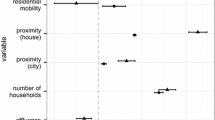Abstract
This paper presents an algorithm for the complete specification of multinomial discrete choice models to predict the spatial preferences of attackers. The formulation employed is a modification of models previously applied in transportation flow and crime analysis. A breaking and entering crime data set is employed to compare the efficacy of this model with traditional hot spot models. Discrete choice models are shown to perform as well as, or better than such models and offer more interpretable results.







Similar content being viewed by others
Notes
The presentation of multinomial discrete choice models here is adapted from (Ben-Akiva and Lerman 1985) and is kept notationally consistent with that work when possible. A notable difference is that the presentation here assumes a single decision maker.
Note that this formalization permits an element of the choice set to be selected in multiple observations, i.e., it is possible that s i = s j for some i ≠ j.
The selected predictors, ϕ30 and ϕ66, represent distance to the nearest federal highway and population density, respectively. The details of the relationship of these predictors to residential breaking and entering crime is outside the scope of this paper and left to criminologists to interpret.
References
Ben-Akiva M, Lerman SR (1985) Discrete choice analysis. The MIT Press, Cambridge
Brown DE (1998) The regional crime analysis program (ReCAP): a framework for mining data to catch criminals. In: Proceedings of the 1998 IEEE international conference on systems, man, and cybernetics, pp 2848–2853
Brown DE, Dalton J, Hoyle H (2004) Spatial forecast methods for terrorist events in urban environments. In: Proceedings of the second NSF/NIJ symposium on intelligence and security informatics. Lecture Notes in Computer Science, Tuscon, Arizona. Springer, Heidelberg, pp 426–435
Fotheringham AS (1986) Modelling hierarchical destination choice. Environ Plan A 18:401–418
Fotheringham AS, O’Kelly ME (1989) Spatial interaction models: formulations and applications. Kluwer, Dordrecht
Fotheringham AS, Brunsdon C, Charlton M (2000) Quantitative geography. Sage Publications Ltd, London
Hastie T, Tibshirani R, Friedman J (2001) The elements of statistical learning; data mining inference and prediction. Springer, Heidelberg
Johnson NLm, Kotz S (1970) Continuous Univariate Distributions—1. Wiley, New York
Lia H, Brown DE (2003) Criminal incident prediction using a a point-pattern-based density model. Int J Forecasting 19:603–622
McFadden D (1974) Conditional logit analysis of qualitative choice behavior, Chapter 4. Academic, New York, pp 105–142
Team RDC (2004) R: a language and environment for statistical computing. R Foundation for Statistical Computing, Vienna
Author information
Authors and Affiliations
Corresponding author
Rights and permissions
About this article
Cite this article
Smith, M.A., Brown, D.E. Discrete choice analysis of spatial attack sites. ISeB 5, 255–274 (2007). https://doi.org/10.1007/s10257-007-0045-1
Published:
Issue Date:
DOI: https://doi.org/10.1007/s10257-007-0045-1




